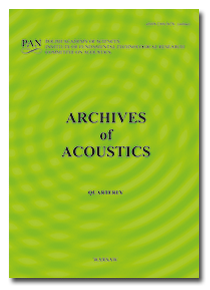Archives of Acoustics,
31, 4(S), pp. 29-34, 2006
Modeling and ultrasonic examination of common carotid artery wall thickness changes
The paper describes the initial results of numeric analysis of plane-strain of a model of
the human common carotid artery. The results of computer modeling were compared with
the experimental data obtained by means of ultrasonic measurements of the changes in the
thickness of the common carotid artery wall. The ultrasonic examination was carried out on
a 34 years old healthy male using the VED apparatus designed by the authors to measure the
elasticity of arteries. The numeric analysis was made by means of the finite element method
(FEM) using the MARC K7 programming of the Analysis Research Corporation based on the
operating system UNIX. As a model of the common carotid artery the authors used a hollow
cylinder made of the isotropic, homogeneous, almost incompressible material (Poisson’s constant
$\nu = 0.4999$) having the Young’s module $E = 159.2$ kPa and the combined thickness
of the internal and middle layer IMT = 0.52 mm. The modeling of plane-strain concerned
the effect of the change in the internal radius and the change in the cylinder wall thickness as
a result of the static change of pressure inside the cylinder within the values of 0–45 mmHg.
The study obtained satisfactory results in the computer simulation of the changes in the artery
walls thickness.
the human common carotid artery. The results of computer modeling were compared with
the experimental data obtained by means of ultrasonic measurements of the changes in the
thickness of the common carotid artery wall. The ultrasonic examination was carried out on
a 34 years old healthy male using the VED apparatus designed by the authors to measure the
elasticity of arteries. The numeric analysis was made by means of the finite element method
(FEM) using the MARC K7 programming of the Analysis Research Corporation based on the
operating system UNIX. As a model of the common carotid artery the authors used a hollow
cylinder made of the isotropic, homogeneous, almost incompressible material (Poisson’s constant
$\nu = 0.4999$) having the Young’s module $E = 159.2$ kPa and the combined thickness
of the internal and middle layer IMT = 0.52 mm. The modeling of plane-strain concerned
the effect of the change in the internal radius and the change in the cylinder wall thickness as
a result of the static change of pressure inside the cylinder within the values of 0–45 mmHg.
The study obtained satisfactory results in the computer simulation of the changes in the artery
walls thickness.
Keywords:
ultrasound, elasticity of the common carotid artery wall, wall thickness.
Full Text:
PDF
Copyright © Polish Academy of Sciences & Institute of Fundamental Technological Research (IPPT PAN).





